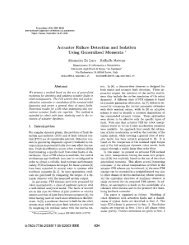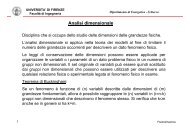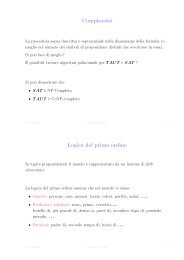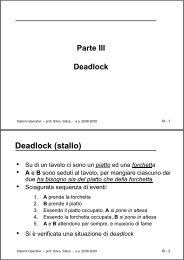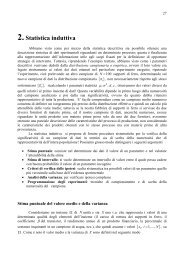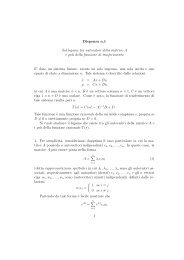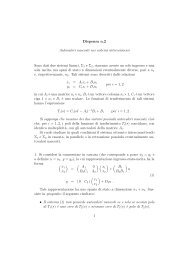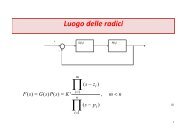INTRODUCTION TO AI STRIPS PLANNING
AI&Games-Lecture2-part1.pdf
AI&Games-Lecture2-part1.pdf
Create successful ePaper yourself
Turn your PDF publications into a flip-book with our unique Google optimized e-Paper software.
Stavros Vassos, University of Athens, Greece<br />
stavrosv@di.uoa.gr<br />
May 2012<br />
<strong>INTRODUCTION</strong> <strong>TO</strong> <strong>AI</strong><br />
<strong>STRIPS</strong> <strong>PLANNING</strong><br />
.. and Applications to Video-games!
Course overview<br />
2<br />
Lecture 1: Game-inspired competitions for <strong>AI</strong> research,<br />
<strong>AI</strong> decision making for non-player characters in games<br />
Lecture 2: <strong>STRIPS</strong> planning, state-space search<br />
Lecture 3: Planning Domain Definition Language (PDDL),<br />
using an award winning planner to solve Sokoban<br />
Lecture 4: Planning graphs, domain independent<br />
heuristics for <strong>STRIPS</strong> planning<br />
Lecture 5: Employing <strong>STRIPS</strong> planning in games:<br />
SimpleFPS, iThinkUnity3D, SmartWorkersRTS<br />
Lecture 6: Planning beyond <strong>STRIPS</strong>
Goal Oriented Action Planning (GOAP)<br />
3<br />
Video Games:<br />
Finite State Machines<br />
Decision Diagrams<br />
Behavior Trees<br />
Goal Oriented Action Planning<br />
Academic <strong>AI</strong> on agents:<br />
Knowledge representation, First-order logic,<br />
Classical planning, Planning with preferences, …<br />
Belief-Desire-Intention architecture, Agent-based<br />
programming, …<br />
Probabilistic reasoning, Bayesian networks,<br />
Utility theory, Markov Decision Processes, …
Goal Oriented Action Planning (GOAP)<br />
4<br />
Search for a plan that achieves the goal in the current<br />
state<br />
Move<br />
into room<br />
Move<br />
to door<br />
Preconditions: Door open<br />
Effects: In room<br />
Preconditions: -<br />
Effects: At door<br />
In room<br />
Unlock<br />
door<br />
Preconditions: Hold key<br />
Effects: Door open<br />
Kick<br />
door<br />
Preconditions: -<br />
Effects: Door open
Goal Oriented Action Planning (GOAP)<br />
5<br />
Search for a plan that achieves the goal in the current<br />
state<br />
There is a standard formalism for representing such<br />
problems in <strong>AI</strong> literature and a large body of work!<br />
Video-games: The best strategy is to use the existing<br />
formalism and take advantage of the work in the<br />
literature
Course overview<br />
6<br />
Lecture 1: Game-inspired competitions for <strong>AI</strong> research,<br />
<strong>AI</strong> decision making for non-player characters in games<br />
Lecture 2: <strong>STRIPS</strong> planning, state-space search<br />
Lecture 3: Planning Domain Definition Language (PDDL),<br />
using an award winning planner to solve Sokoban<br />
Lecture 4: Planning graphs, domain independent<br />
heuristics for <strong>STRIPS</strong> planning<br />
Lecture 5: Employing <strong>STRIPS</strong> planning in games:<br />
SimpleFPS, iThinkUnity3D, SmartWorkersRTS<br />
Lecture 6: Planning beyond <strong>STRIPS</strong>
<strong>STRIPS</strong> planning<br />
7<br />
Typical description of a planning problem:<br />
Initial state<br />
Goal<br />
Available actions<br />
Typical solution of a planning problem:<br />
A sequence of actions that when executed in the initial<br />
state results in a state that satisfies the goal condition.<br />
Planning: The automatic discovery of such solutions
What is a planning problem?<br />
8<br />
Let’s start with a simple example..
What is a planning problem?<br />
9<br />
Given:<br />
Initial state
What is a planning problem?<br />
10<br />
Given:<br />
Initial state<br />
Goal
What is a planning problem?<br />
11<br />
Given:<br />
Initial state<br />
Goal<br />
Available actions
What is a planning problem?<br />
12<br />
Given:<br />
Initial state<br />
Goal<br />
Available actions<br />
Find:<br />
A sequence of actions that achieves the goal<br />
E.g.: [Left, Down, Left, Up, …]
What is a planning problem?<br />
13<br />
Given:<br />
Initial state<br />
Goal<br />
Available actions<br />
Find:<br />
A sequence of actions that achieves the goal<br />
A method that is capable of finding a solution for every<br />
initial state and goal
What is a planning problem?<br />
14<br />
Given:<br />
Initial state<br />
Goal<br />
Available actions<br />
Find:<br />
A sequence of actions that achieves the goal<br />
A method that is capable of finding a solution for every<br />
application domain
Use of planning in real applications<br />
15<br />
Scheduling<br />
Hubble Space Telescope
Use of planning in real applications<br />
16<br />
KIVA Robots: robots make inventory isles move<br />
instead of workers<br />
youtube link
Use of planning in real applications<br />
17<br />
Autonomous agents with planning capabilities for<br />
specifying the behavior (Intelligent Agents/<br />
Cognitive Robots)<br />
UAV DARPA Grand/Urban Challenge, Honda<br />
ASIMO
<strong>STRIPS</strong> planning<br />
18<br />
Typical description of a planning problem:<br />
Initial state<br />
Goal<br />
Available actions
<strong>STRIPS</strong> planning<br />
19<br />
Blocks world domain<br />
Initial state: s 0<br />
Goal: g<br />
Α Β C<br />
s 0<br />
Α<br />
Β<br />
C<br />
g<br />
Available actions: moving a block<br />
• from the table to the top of another block<br />
• from the top of another block to the table<br />
• from the top of one block to the top of another block
<strong>STRIPS</strong> planning<br />
20<br />
Initial state<br />
Representation of the properties of the<br />
domain using first order logic literals<br />
Blocks world<br />
On(b,x):<br />
• block b is on top of x, where x is another<br />
block or the table<br />
Clear(x):<br />
• a block can be placed on top of x<br />
Α Β C<br />
On(Α,Table)<br />
On(Β,Table)<br />
On(C,Table)<br />
Clear(Α)<br />
Clear(Β)<br />
Clear(C)<br />
s 0
<strong>STRIPS</strong> planning<br />
21<br />
Initial state<br />
Representation of the properties of the<br />
domain using first order logic literals<br />
Ground and function-free<br />
Completely specified<br />
based on a closed-world assumption<br />
Α Β C<br />
On(Α,Table)<br />
On(Β,Table)<br />
On(C,Table)<br />
Clear(Α)<br />
Clear(Β)<br />
Clear(C)<br />
s 0
<strong>STRIPS</strong> planning<br />
22<br />
Initial state<br />
Closed-world<br />
assumption<br />
Any literal not<br />
mentioned in the<br />
description of the<br />
state are assumed<br />
to be false!<br />
On(Α,Α)<br />
On(Α,Β)<br />
On(Α,C)<br />
On(Β,Α)<br />
On(Β,Β)<br />
On(Β,C)<br />
On(C,Α)<br />
On(C,Β)<br />
On(C,C)<br />
On(Α,Α)<br />
On(Α,Β)<br />
On(Α,C)<br />
On(Table,Α)<br />
On(Table,Β)<br />
On(Table,C)<br />
On(Table,Table)<br />
Clear(Table)<br />
Α Β C<br />
On(Α,Table)<br />
On(Β,Table)<br />
On(C,Table)<br />
Clear(Α)<br />
Clear(Β)<br />
Clear(C)<br />
s 0
<strong>STRIPS</strong> planning<br />
23<br />
Goal<br />
Representation of the properties of the<br />
domain using first order logic literals<br />
Α<br />
Β<br />
C<br />
Ground and function-free<br />
Partially specified<br />
(no closed-world assumption)<br />
A state s satisfies goal g if it contains all<br />
literals in g (more literals may be in s)<br />
On(Α,Β)<br />
On(Β,C)<br />
g
<strong>STRIPS</strong> planning<br />
24<br />
<br />
The initial state and goal<br />
condition are described using<br />
first-order logic literals:<br />
Α Β C<br />
Α<br />
Β<br />
C<br />
ground<br />
function-free<br />
positive<br />
the list of literals typically<br />
forms a logical conjunction<br />
On(Α,Table)<br />
On(Β,Table)<br />
On(C,Table)<br />
Clear(Α)<br />
Clear(Β)<br />
Clear(C)<br />
On(Α,Β)<br />
On(Β,C)<br />
s 0<br />
g
<strong>STRIPS</strong> planning<br />
25<br />
Available actions<br />
Move:<br />
• from the table to the<br />
top of another block<br />
• from the top of<br />
another block to the<br />
table<br />
• from the top of one<br />
block to the top of<br />
another block<br />
Α Β C<br />
On(Α,Table)<br />
On(Β,Table)<br />
On(C,Table)<br />
Clear(Α)<br />
Clear(Β)<br />
Clear(C)<br />
s 0
<strong>STRIPS</strong> planning<br />
26<br />
Available actions<br />
Move:<br />
• from the table to the<br />
top of another block<br />
• from the top of<br />
another block to the<br />
table<br />
• from the top of one<br />
block to the top of<br />
another block<br />
Α Β C Α<br />
On(Α,Table)<br />
On(Β,Table)<br />
On(C,Table)<br />
Clear(Α)<br />
Clear(Β)<br />
Clear(C)<br />
Move(Β,Table,C)<br />
Β<br />
C<br />
???<br />
s 0 s 1
<strong>STRIPS</strong> planning<br />
27<br />
Available actions<br />
Preconditions: literals<br />
denoting what needs to<br />
be in the state for the<br />
action to be applicable<br />
Effects: literals denoting<br />
how the state is<br />
transformed when the<br />
action is applied.<br />
Α Β C Α<br />
On(Α,Table)<br />
On(Β,Table)<br />
On(C,Table)<br />
Clear(Α)<br />
Clear(Β)<br />
Clear(C)<br />
Move(Β,Table,C)<br />
s 0 s 1<br />
Β<br />
C<br />
???
<strong>STRIPS</strong> planning<br />
28<br />
Available actions<br />
Β<br />
Preconditions:<br />
• On(b,x)<br />
• Clear(b)<br />
• Clear(y)<br />
Effects:<br />
• On(b,y)<br />
• Clear(x)<br />
• On(b,x)<br />
• Clear(y)<br />
Α Β C Α<br />
On(Α,Table)<br />
On(Β,Table)<br />
On(C,Table)<br />
Clear(Α)<br />
Clear(Β)<br />
Clear(C)<br />
Move(Β,Table,C)<br />
s 0 s 1<br />
C<br />
???
<strong>STRIPS</strong> planning<br />
29<br />
Available actions<br />
Β<br />
Preconditions:<br />
• On(Β,Table)<br />
• Clear(Β)<br />
• Clear(C)<br />
Effects:<br />
• On(Β,C)<br />
• Clear(Table)<br />
• On(Β,Table)<br />
• Clear(C)<br />
Α Β C Α<br />
On(Α,Table)<br />
On(Β,Table)<br />
On(C,Table)<br />
Clear(Α)<br />
Clear(Β)<br />
Clear(C)<br />
Move(Β,Table,C)<br />
s 0 s 1<br />
C<br />
???
<strong>STRIPS</strong> planning<br />
30<br />
Available actions<br />
Β<br />
Preconditions:<br />
• On(Β,Table)<br />
• Clear(Β)<br />
• Clear(C)<br />
Effects:<br />
• On(Β,C)<br />
• Clear(Table)<br />
• On(Β,Table)<br />
• Clear(C)<br />
Α Β C Α<br />
On(Α,Table)<br />
On(Β,Table)<br />
On(C,Table)<br />
Clear(Α)<br />
Clear(Β)<br />
Clear(C)<br />
Move(Β,Table,C)<br />
C<br />
On(Α,Table)<br />
On(Β,C)<br />
On(C,Table)<br />
Clear(Α)<br />
Clear(Β)<br />
Clear(Table)<br />
s 0 s 1
<strong>STRIPS</strong> planning<br />
31<br />
Available actions<br />
Preconditions:<br />
• On(b,x)<br />
• Clear(b)<br />
• Clear(y)<br />
Effects:<br />
• On(b,y)<br />
• Clear(x)<br />
• On(b,x)<br />
• Clear(y)<br />
Α<br />
Β<br />
C<br />
On(Α,Table)<br />
On(Β,C)<br />
On(C,Table)<br />
Clear(Α)<br />
Clear(Β)<br />
Clear(Table)<br />
Move(C,Table,Α)<br />
???<br />
???<br />
s 1 s 2
<strong>STRIPS</strong> planning<br />
32<br />
Available actions<br />
Preconditions:<br />
• On(C,Table)<br />
• Clear(C)<br />
• Clear(Α)<br />
Effects:<br />
• On(C,Α)<br />
• Clear(Table)<br />
• On(C,Table)<br />
• Clear(Α)<br />
Α<br />
Β<br />
C<br />
On(Α,Table)<br />
On(Β,C)<br />
On(C,Table)<br />
Clear(Α)<br />
Clear(Β)<br />
Clear(Table)<br />
Move(C,Table,Α)<br />
???<br />
???<br />
s 1 s 2
<strong>STRIPS</strong> planning<br />
33<br />
Available actions<br />
Α<br />
Β<br />
Β<br />
Preconditions:<br />
• On(Α,Table)<br />
• Clear(Α)<br />
• Clear(Β)<br />
Effects:<br />
• On(Α,Β)<br />
• Clear(Table)<br />
• On(Α,Table)<br />
• Clear(Β)<br />
Α<br />
C<br />
On(Α,Table)<br />
On(Β,C)<br />
On(C,Table)<br />
Clear(Α)<br />
Clear(Β)<br />
Clear(Table)<br />
Move(Α,Table,Β)<br />
C<br />
???<br />
s 1 s 2
<strong>STRIPS</strong> planning<br />
34<br />
Available actions<br />
Α<br />
Β<br />
Β<br />
Preconditions:<br />
• On(Α,Table)<br />
• Clear(Α)<br />
• Clear(Β)<br />
Effects:<br />
• On(Α,Β)<br />
• Clear(Table)<br />
• On(Α,Table)<br />
• Clear(Β)<br />
Α<br />
C<br />
On(Α,Table)<br />
On(Β,C)<br />
On(C,Table)<br />
Clear(Α)<br />
Clear(Β)<br />
Clear(Table)<br />
Move(Α,Table,Β)<br />
C<br />
On(Α,Β)<br />
On(Β,C)<br />
On(C,Table)<br />
Clear(Α)<br />
Clear(Table)<br />
s 1 s 2
<strong>STRIPS</strong> planning<br />
35<br />
Α Β C Α<br />
Β<br />
C<br />
Α<br />
Β<br />
C<br />
On(Α,Table)<br />
On(Β,Table)<br />
On(C,Table)<br />
Clear(Α)<br />
Clear(Β)<br />
Clear(C)<br />
On(Α,Table)<br />
On(Β,C)<br />
On(C,Table)<br />
Clear(Α)<br />
Clear(Β)<br />
Clear(Table)<br />
On(Α,Β)<br />
On(Β,C)<br />
On(C,Table)<br />
Clear(Α)<br />
Clear(Table)<br />
s 0<br />
Move(Β,Table,C)<br />
s 1<br />
Move(Α,Table,Β)<br />
s 2
<strong>STRIPS</strong> planning<br />
36<br />
Α<br />
Α<br />
Β<br />
Β<br />
Β<br />
Α Β C Α<br />
C<br />
C<br />
C<br />
On(Α,Table)<br />
On(Β,Table)<br />
On(C,Table)<br />
Clear(Α)<br />
Clear(Β)<br />
Clear(C)<br />
On(Α,Table)<br />
On(Β,C)<br />
On(C,Table)<br />
Clear(Α)<br />
Clear(Β)<br />
Clear(Table)<br />
On(Α,Β)<br />
On(Β,C)<br />
On(C,Table)<br />
Clear(Α)<br />
Clear(Table)<br />
On(Α,Β)<br />
On(Β,C)<br />
Move(Β,Table,C)<br />
Move(Α,Table,Β)<br />
s 0 s 1 s 2<br />
g
<strong>STRIPS</strong> planning<br />
37<br />
Is our <strong>STRIPS</strong> representation of the<br />
blocks world correct?<br />
Consider moving back blocks A<br />
and B back to the table<br />
Α<br />
Β<br />
C<br />
On(Α,Β)<br />
On(Β,C)<br />
On(C,Table)<br />
Clear(Α)<br />
Clear(Table)
<strong>STRIPS</strong> planning<br />
38<br />
Α<br />
Β<br />
Β<br />
C<br />
Α<br />
C<br />
Α Β C<br />
On(Α,Β)<br />
On(Β,C)<br />
On(C,Table)<br />
Clear(Α)<br />
Clear(Table)<br />
On(Α,Table)<br />
On(Β,C)<br />
On(C,Table)<br />
Clear(Α)<br />
Clear(Β)<br />
???<br />
Move(A,B,Table)<br />
Move(B,C,Table)<br />
s 2 s 3 s 4
<strong>STRIPS</strong> planning<br />
39<br />
Is our <strong>STRIPS</strong> representation of the<br />
blocks world correct?<br />
Consider moving back blocks A<br />
and B back to the table<br />
Clear(Table) needs to be treated<br />
differently<br />
Move(b,x,y)<br />
MoveToTable(b,x)<br />
Α<br />
Β<br />
C<br />
On(Α,Β)<br />
On(Β,C)<br />
On(C,Table)<br />
Clear(Α)<br />
Clear(Table)
<strong>STRIPS</strong> planning<br />
40<br />
Init( On(Α,Table) On(Β,Table) On(C,Table)<br />
Clear(Α) Clear(Β) Clear(C) )<br />
Goal( On(Α,Β) On(Β,C) )<br />
Action( Move(b,x,y),<br />
PRECONDITIONS: On(b,x) Clear(b) Clear(y)<br />
EFFECTS: On(b,y) Clear(x) On(b,x)<br />
Clear(y) )<br />
Action( MoveToTable(b,x),<br />
PRECONDITIONS: On(b,x) Clear(b)<br />
EFFECTS: On(b,Table) Clear(x) On(b,x) )
<strong>STRIPS</strong> planning<br />
41<br />
Init( On(Α,Table) On(Β,Table) On(C,Table)<br />
! Variables that appear in preconditions and effects<br />
Clear(Α) Clear(Β) Clear(C) )<br />
need to be parameters of the action schema<br />
Goal( On(Α,Β) On(Β,C) )<br />
Action( Move(b,x,y),<br />
PRECONDITIONS: On(b,x) Clear(b) Clear(y)<br />
EFFECTS: On(b,y) Clear(x) On(b,x)<br />
Clear(y) )<br />
Action( MoveToTable(b,x),<br />
PRECONDITIONS: On(b,x) Clear(b)<br />
EFFECTS: On(b,Table) Clear(x) On(b,x) )
<strong>STRIPS</strong> planning<br />
42<br />
Init( On(Α,Table) On(Β,Table) On(C,Table)<br />
! Variables that appear in preconditions and effects<br />
Clear(Α) Clear(Β) Clear(C) )<br />
need to be parameters of the action schema<br />
Goal( On(Α,Β) On(Β,C) )<br />
Action( Move(b,x,y),<br />
PRECONDITIONS: On(b,x) Clear(b) Clear(y)<br />
EFFECTS: On(b,y) Clear(x) On(b,x)<br />
Clear(y) )<br />
Action( MoveToTable(b,x),<br />
PRECONDITIONS: On(b,x) Clear(b)<br />
EFFECTS: On(b,Table) Clear(x) On(b,x) )
<strong>STRIPS</strong> planning<br />
43<br />
Init( On(Α,Table) On(Β,Table) On(C,Table)<br />
! Variables that appear in preconditions and effects<br />
Clear(Α) Clear(Β) Clear(C) )<br />
need to be parameters of the action schema<br />
Goal( On(Α,Β) On(Β,C) )<br />
Action( Move(b,x,y),<br />
PRECONDITIONS: On(b,x) Clear(b) Clear(y)<br />
EFFECTS: On(b,y) Clear(x) On(b,x)<br />
Clear(y) )<br />
Action( MoveToTable(b,x),<br />
PRECONDITIONS: On(b,x) Clear(b)<br />
EFFECTS: On(b,Table) Clear(x) On(b,x) )
<strong>STRIPS</strong> planning<br />
44<br />
Init( On(Α,Table) On(Β,Table) On(C,Table)<br />
Clear(Α) Clear(Β) Clear(C) )<br />
Goal( On(Α,Β) On(Β,C) )<br />
Action( Move(b,x,y),<br />
PRECONDITIONS: On(b,x) Clear(b) Clear(y)<br />
EFFECTS: On(b,y) Clear(x) On(b,x)<br />
Clear(y) )<br />
Action( MoveToTable(b,x),<br />
PRECONDITIONS: On(b,x) Clear(b)<br />
EFFECTS: On(b,Table) Clear(x) On(b,x) )<br />
! Simplified <strong>STRIPS</strong> version of Figure 11.4 in <strong>AI</strong>MA 2 nd Ed.
<strong>STRIPS</strong> planning<br />
45<br />
Gripper domain<br />
Init( On-Table(Α) On-Table(Β) On-table(C)<br />
Clear(Α) Clear(Β) Clear(C) Grip-Empty )<br />
Goal( On(Α,Β) On(Β,C) )<br />
Action( Pick-up(x), … )<br />
Action( Put-down(x), … )<br />
Action( Stack(top,below), … )<br />
Action( Unstack(top,below), … )
<strong>STRIPS</strong> planning<br />
46<br />
Reasoning about action and change<br />
Since 1971 that <strong>STRIPS</strong> planning was proposed by R. E.<br />
Fikes and N. J. Nilsson, more expressive planning<br />
formalisms have been developed based on <strong>STRIPS</strong>!<br />
ADL allows open worlds, conditional effects, quantifiers<br />
[Pednault 1988]<br />
Situation calculus [McCarthy, Hayes 1969] [Reiter 2001]<br />
is based on first-order logic allowing rich<br />
representations<br />
Action languages A, Fluent calculus, Event calculus, …
Bibliography<br />
47<br />
Material<br />
• Artificial Intelligence: A Modern Approach 2nd Ed. Stuart Russell, Peter<br />
Norvig. Prentice Hall, 2003 Section 11.1<br />
References<br />
• <strong>STRIPS</strong>: A new approach to the application of theorem proving to<br />
problem solving. Richard E. Fikes, Nils J. Nilsson. Artificial Intelligence,<br />
Vol. 2, No. 3-4, 1971.<br />
• Synthesizing plans that contain actions with context-dependent effects.<br />
E. P. D. Pednault. Computational Intelligence, Vol. 4, No. 3. 1988.<br />
• Some Philosophical Problems from the Standpoint of Artificial<br />
Intelligence. John McCarthy, Patrick J. Hayes. Machine Intelligence, Vol.<br />
4, 1969.<br />
• Knowledge in Action: Logical Foundations for Specifying and<br />
Implementing Dynamical Systems. Raymond Reiter. MIT Press, 2001.




